The Two-Handed Backhand...Again
right hands—hitting arm structures—grips and hips—trial and error
There’s a recent Instagram video by Karue Sell (current coach of ATP #69 Marcos Giron) from My Tennis HQ that highlighted a feel for the two-handed backhand that ran counter to common tennis advice: use your right hand more like a one-handed backhand.1 Check out an in-depth lesson below:
What’s interesting here is that Sell says he got a lot of pushback from couch experts on this tip. I’m writing this piece because, like Sell (or the old Sell), I also tend (or used to) to think of the backhand as a left-hand shot (for a righty). After watching his video a few weeks ago on using the right hand more I experimented with this feel on some of my clients who were struggling with their two-hand backhand. It worked better for some than others, which is pretty normal, but I think the topic deserves an in-depth examination of why this advice is great for certain backhand swings. After a few weeks of turning this over in my head, I think I’ve come to a decent explanation, or at least a solid framework to start from. Let’s dig in.
Hitting Arm Structures
In the comments of the video a top pro, Filip Peliwo, offers his feel that is counter to Sell’s (and typical of much coaching advice): he uses his left hand more (highlighted).
Then he finishes with “just depends on how you time it” which is typically ambiguous; language is not well suited to accurately convey motor patterns or “feels”. What I think he means is, it depends on how you swing and where you contact the ball.
Let’s take a look at three hitting arm structures that can occur on a two-hand backhand: (a) a straight left arm with a bent right arm; (b) a double-bend; and (c) a straight right arm.
Note: these are tendencies. Players that I group in one structure will very often hit with another structure depending on the type of shot they are trying to hit, the incoming ball, their positioning, etc. For example, I group Djokovic in the “straight left arm with bent right arm” structure, but very often, perhaps even more often, he will hit with a double bend. So keep in mind that categories are not discrete and that player groupings are loose/fluid. I grouped them roughly and based on what I think they tend to produce on a neutral rally ball where they aren’t rushed, cramped, trying to roll an angle or block a return, etc. This also means that on certain shots the player might feel or use one hand more than the other to effect topspin, angle, absorb pace, redirect, etc., but that both hands are used more for different shots/strokes.
Straight left arm with a bent right arm
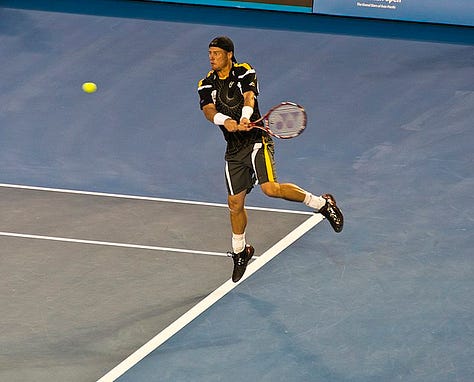
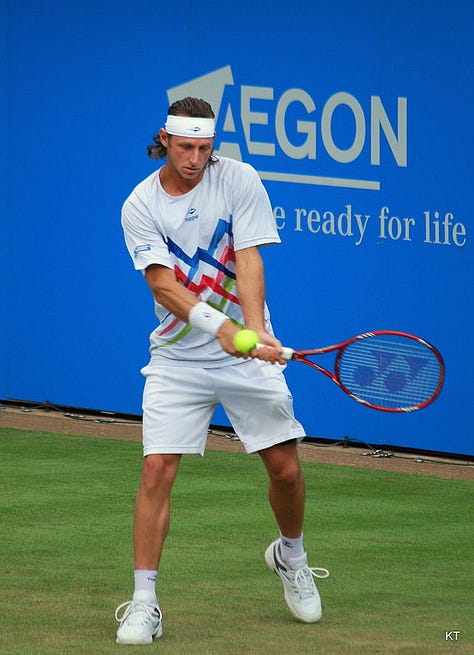
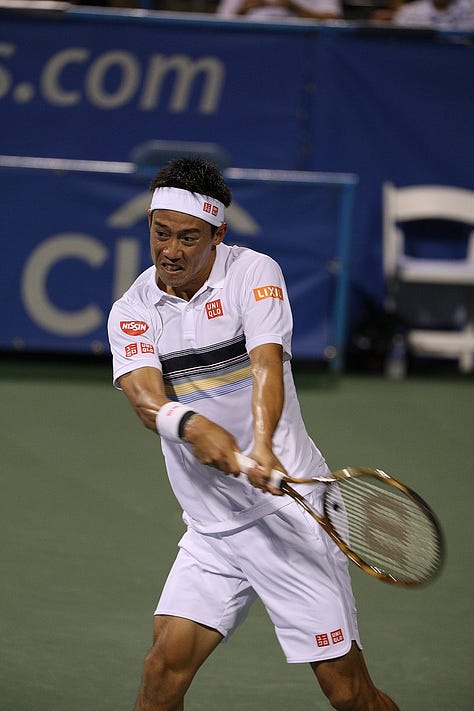
This is perhaps the most common arm structure on the backhand and one that tends to occur in some of the best backhands of all time. I’d argue Nalbandian, Djokovic, Safin, Soderling, Nishikori, Hewitt, Alcaraz, and a host of others fit in this box more than any other.2
Double-bend
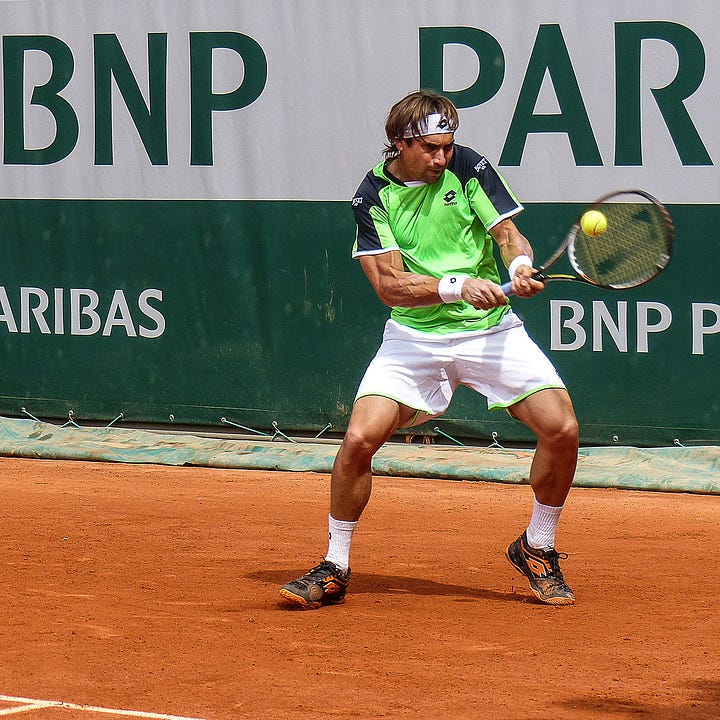
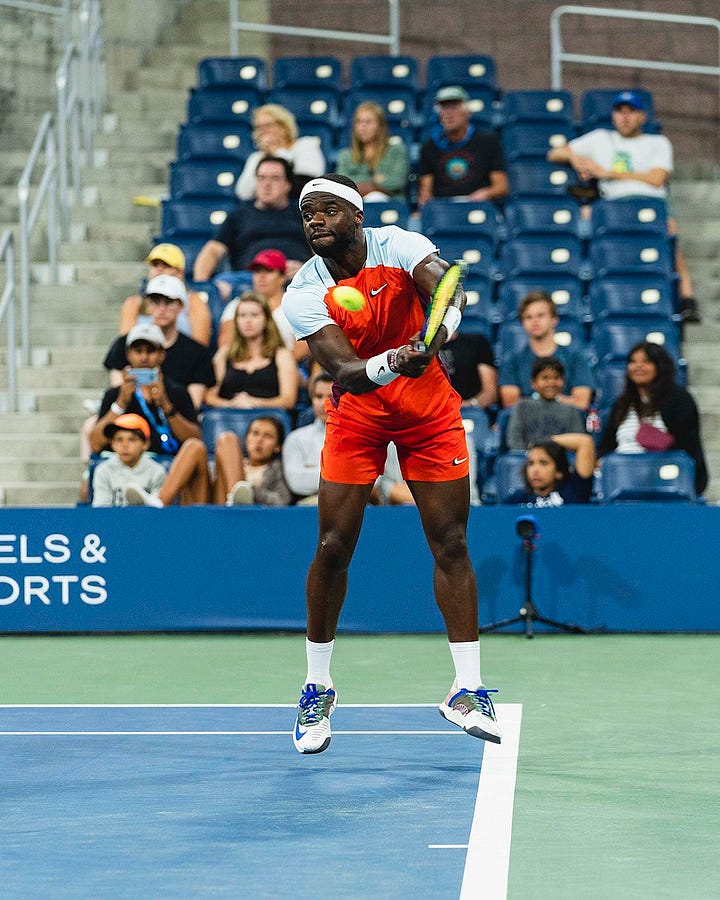

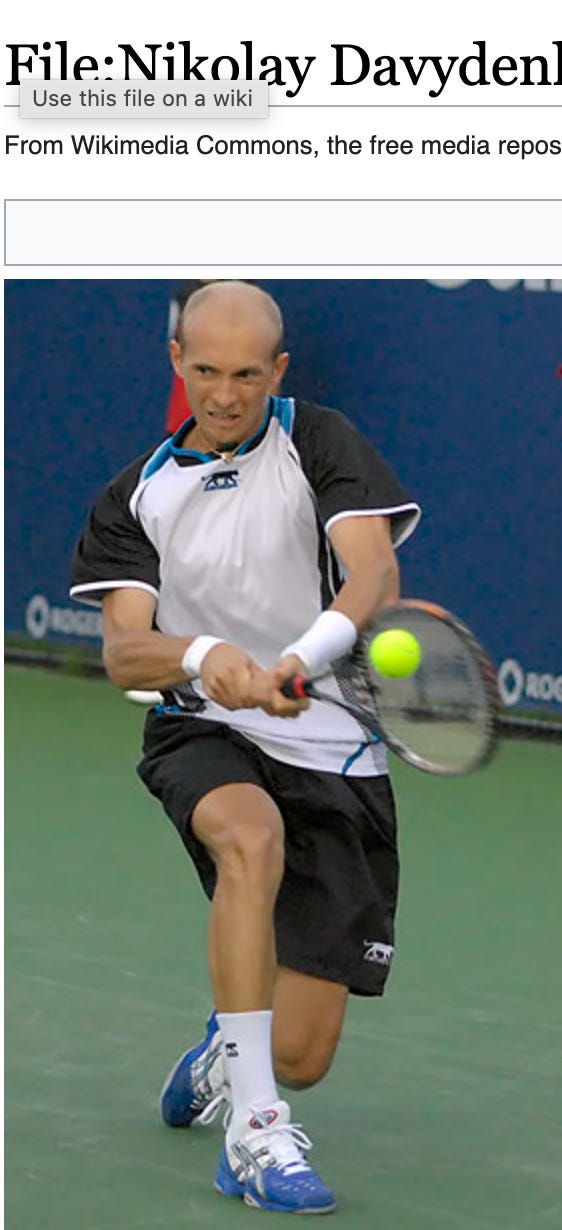
The double-bend arm structure is more common on the WTA tour but features a host of men’s players including Zverev, Ferrer, Davydenko, Sinner, Medvedev, Rune, Cilic, Tomic, and Murray.3 I would argue that our Instagram commenter from above, Filip Peliwo, fits in this box also. You can catch a glimpse of his backhand here.
Straight right-arm
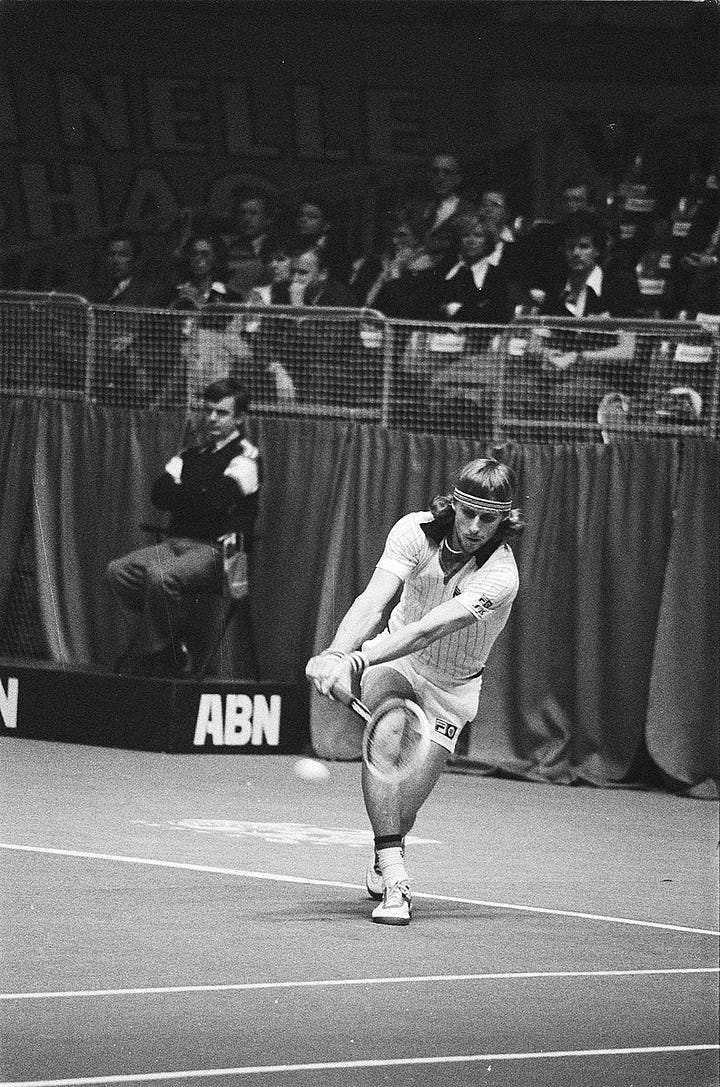
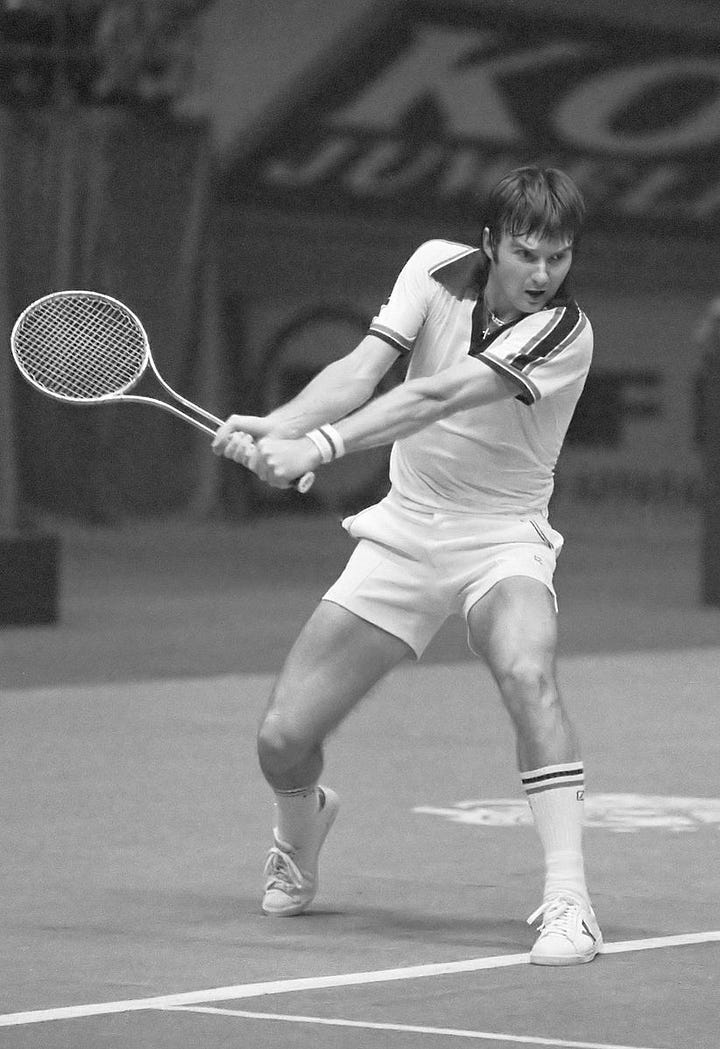
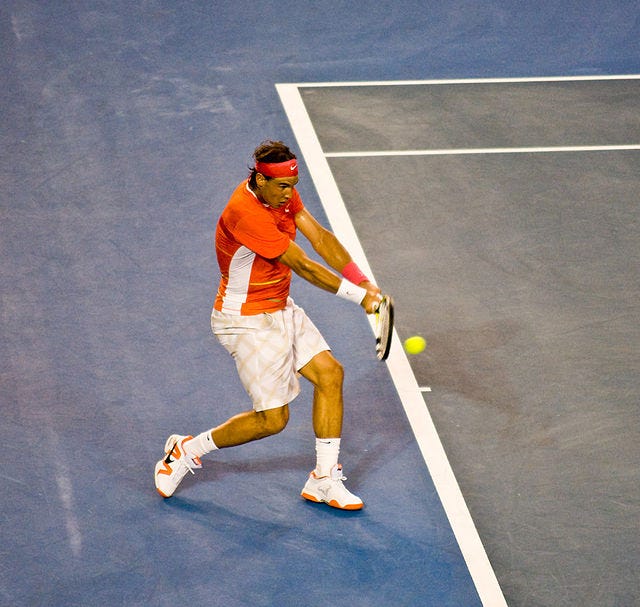

The straight right arm (left for Connors and Nadal) is less common and seen in Agassi, Borg, Courier, Connors, and Nadal.4 Generally we see the hips and chest more open around contact and both arms straighten through contact.
Once again keep in mind these categories are fluid. If you think I’ve miscategorised a certain player: I hear you. I’m just pointing out that there are different swing structures out there and players tend to hit certain ones more than others, or perhaps more accurately, certain players rarely hit certain types (for example, Medvedev would rarely hit with a straight right arm, Agassi would rarely have hit with a double-bend, etc.).
So, what stroke tends to be dominated—or felt—by the left hand, and which by the right?
This is where it can get a little messy and dependent on multiple variables, two of which I’m going to focus on: (a) grips; and (b) hips.
Grips and Hips
If you read my single-backhand article a few weeks ago, you would have seen how the more extreme one-handed backhand grips exhibited by Nicolas Almagro and Richard Gasquet allow for a more front-on orientation with the body. Contact can be made further in front of the body with an extended wrist because the racquet face remains square to target further in front compared to more conservative grips. Below is Almagro:
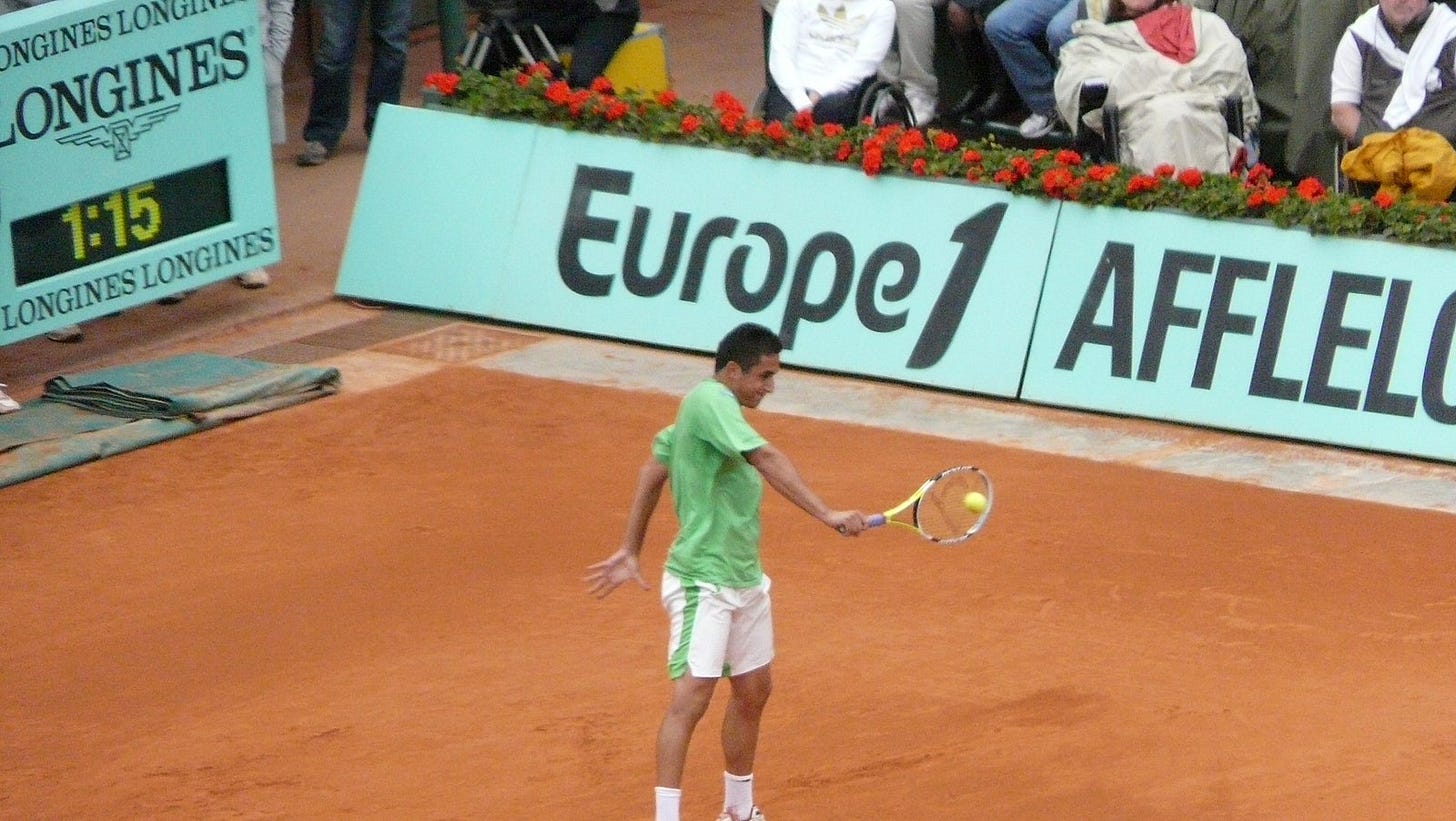
Contact is made way out in front of Almagro’s body and his hips have completely turned (Almagro actually returns with the same side of the racquet for both forehand and backhand).
Now a heuristic for the two-handed backhand: the further in front you make contact (which generally means the earlier or harder you fire your hips so that they open more) the more you want to feel your right hand.5
That’s because as contact gets further in front (like we see in Borg and Agassi) the body tends to open more, and so keeping the strings on target requires that we “push” the racquet more and “roll” it less. If you are having a hard time with those push and roll terms here is a visual below. Watch the next minute or so of this clip from 2MinuteTennis:
You can see Johnson—who is very front on—“rolls” his left hand over the backhand so that his strings finish facing down, his right elbow is tucked low, and the racquet tip finishes the shot pointing right. Djokovic, on the other hand (literally, the other hand) is pushing his right hand more so that he finishes with the strings facing up, the right elbow high, and the racquet tip more neutral.6 The Johnson "roll" technique plagues fellow stars Felix Auger Aliassime and Matteo Berretteni. For different reasons (Matteo doesn't get under the ball with a closed racquet face, and Felix opens his hips very hard and early to catch the ball far in front) they are rolling their top hands in desperate search of topspin. Ironically, if they tried to hit a flatter backhand by using more right hand they would probably hit better backhands without much topspin at all. To see this exaggerated right-hand feel (or absent left-hand feel) in action where players are really extending that push, the racquet tip of some two-handers faces left on the finish (much like a one-handed backhand), as I touched on in the Adelaide Final analysis. Pictures below of Seb Korda and Novak Djokovic:
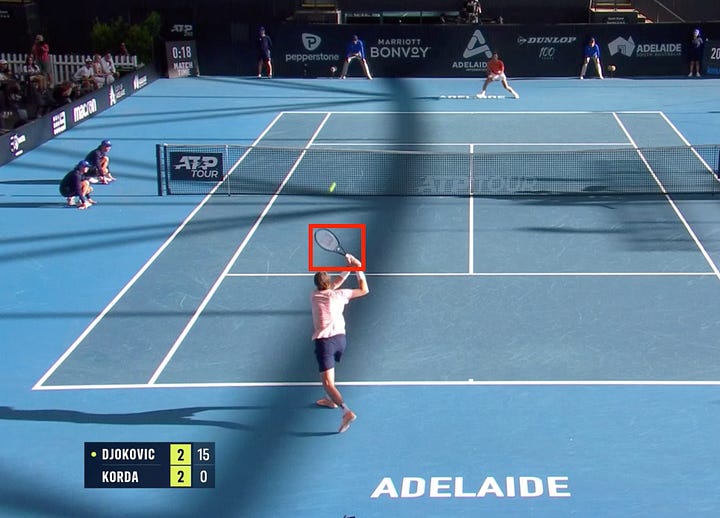

Alcaraz also has this finish in certain backhands, juxtaposed to the one-hand backhand of Tommy Haas:


In these instances, the player is really looking for directional control, and I’d say that is the perk of the right-hand feel. You can direct the ball well in the absence of a lot of topspin because a right-hand dominant backhand swing exaggerates how long the strings remain on target (facing down the court).
So what about the classic “left-hand forehand” feel? Where do we see that and when is it most effective?
Another heuristic: the further back you contact the ball, or the more closed your hips, the more you want to feel your left hand.
Let’s return to two earlier photos to illustrate this:
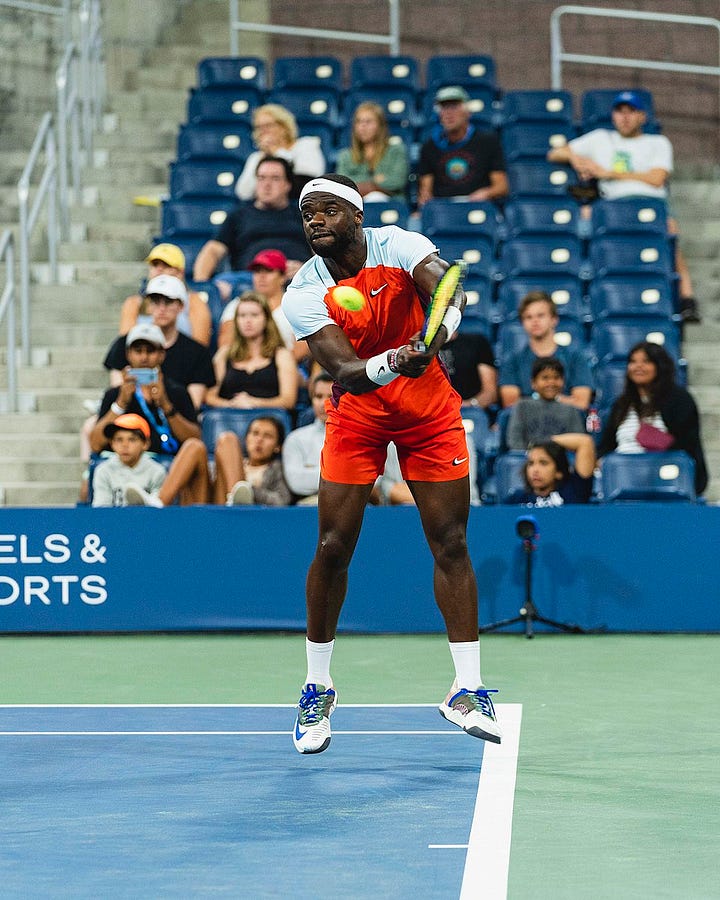

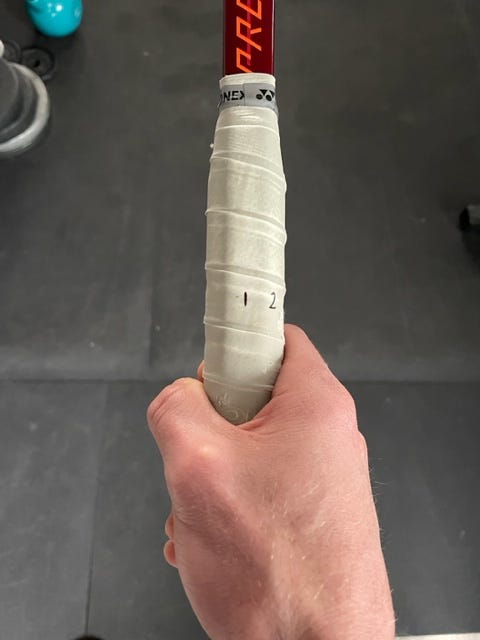
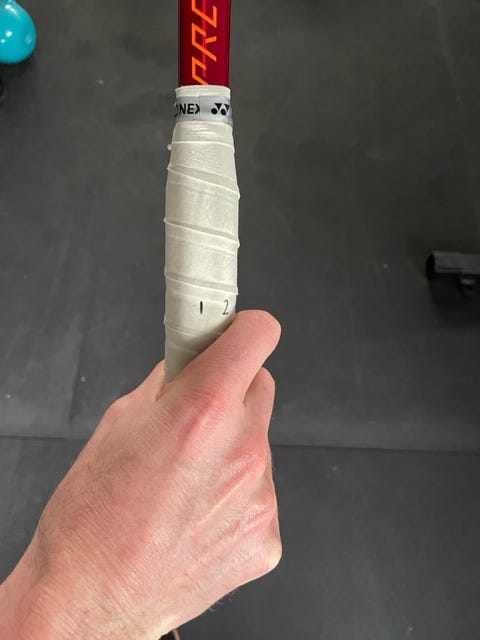
Above we can see that Tiafoe’s late double-bend contact necessitates a left-hand dominant action if he is to square the racquet face and then control the ball. Borg, on the other hand, has made contact low and in front with a straight right arm (and the left arm is extended here too just after contact). It’s essentially a one-hand backhand with a left-hand passenger and if you have watched Borg you will know he finished his backhand with the left hand off the racquet and used an eastern backhand grip on the right hand.
Now in the earlier video comparing Djokovic and Johnson, one of the issues with Johnson is how you can’t see his hands from the back on contact (his body covers his hands giving the impression that he is cramped or jammed up). This isn’t a fatal flaw if you are right-hand dominant on your swing (and I would argue Agassi made contact in a more “jammed” fashion but felt he hit his backhand with his right hand7). If you fire your hips hard and early and make yourself more front-on around contact, your hands will have to appear closer and/or hidden from a back view if you are to have any hope of finding a square racquet on contact. But there are players with great backhands who roll their left hands—namely, Jannik Sinner, David Nalbandian, and Rafael Nadal—and this is achieved by firing their hips less or later in the swing so that they are more side-on around contact. Perhaps a feel is that their hands lead the swing and the hips get pulled through.8 Check out Sinner below:
So the left hand and the hip turn are synced to a certain degree; the more you use one, the less you want to use the other (again, this is a generalisation/heuristic).
Here is Murray with a different angle showcasing a double-bend backhand mostly. Features: late contact, less/late hip turn, huge action with the left hand to almost “scoop” the ball back which results in strings facing down on follow-through with a lower right elbow. He has Sinner’s left-hand feel but with a much flatter swing path and racquet face, which results in a flatter backhand. Both are world-class.
Here is Agassi to compare with Murray. Features: early contact, more hip turn, more right hand to “push” the ball which results in strings facing up/side fence on follow through with a high right elbow finish.
Summary
There are numerous ways to achieve a world-class backhand. However, I think there are certain commonalities that are required to “pair” if this is to occur. Mismatching hand feels and hip action (e.g., firing/opening the hips a lot and using the left hand a lot, like we see in Felix Auger Aliassime and Steve Johnson) is a sure way to reduce your backhand effectiveness.
The TL:DR is this: the more front on you are with hips and shoulders, the more right hand dominant you should be. The more side on you are, the more left hand dominant you should be.
Karue Sell’s advice is spot on: amateurs need to try it because they may not know what hitting structure or hip turn they use on their shot. Just to qualify this, Sell isn’t advocating that all backhands need this, he was just pointing out that the left-hand feel is not a panacea for two-hand backhand woes:
Understanding how your hips, grips, and hands work together can help players experiment with different feels that ultimately help you hit your backhand better, whatever that looks like. Trial and error is part of the deal. No matter how good your coach is, he isn’t you, and he can’t feel exactly what you feel; words can only ever approximate a feeling. A quote from Timothy Gallwey’s “The Inner Game of Tennis” in a prior piece (emphasis added):
"Perhaps in the interest of being able to repeat that way of hitting the ball again or to pass it on to another, the person attempts to describe that stroke in language. But words can only represent actions, ideas and experiences. Language is not the action, and at best can only hint at the subtlety and complexity contained in the stroke. Although the instruction thus conceived can now be stored in the part of the mind that remembers language, it must be acknowledged that remembering the instruction is not the same as remembering the stroke itself.”
The player needs to try different swings and play around with them to gain a more implicit feeling. I just think this framework might help provide a base to start from. Let me know if you end up trying this with any success in the comments.
Enjoy Monte Carlo. I’ll be back with a late analysis on Tuesday or Wednesday next week.
For a right-hander. Flip everything in this article if you are a lefty. My Tennis HQ is a pretty awesome channel—only content that gives you in-depth footage of pro sessions from a guy battling it out on the ATP tour.
Photo credit links: Lleyton Hewitt by Steve Collis, David Nalbandian by Carine06, Kei Nishikori by JC, Andy Murray by Carine06.
Photo credit links: Nikolay Davydenko by ataelw, David Ferrer by Yann Caradec, Frances Tiafoe by All-Pro Reels, Daniil Medvedev by Chris Czermak.
Photo credit links: Bjorn Borg by National Archive, Jimmy Connors by National Archive, Andre Agassi by Wikipedia, Rafael Nadal by Steve Collis.
This is always subjective. For instance, a left-hand feel more in front could be the thought of ten-pin bowling with your left hand, where the palm remains up and extends through to the target.
You’ll also notice that Djokovic’s hips and shoulders are more closed on contact compared to Johnson, and that is what makes it possible to see his hands on contact from a back view.
I believe Sell got the notion of using the right hand from Agassi himself during a session. It’s interesting that Agassi also works with Seb Korda, and you can see that more right-hand feel in his backhand (also as noted in one of the pictures).
An interesting parallel in golf. If you stay side-on in golf which often necessitates that you “flip” your hands (i.e. make them very active, especially the bottom hand—which would equate to the top hand in our tennis example) you often get the dreaded hook shot. Hook shots kill your golf game, but hook shots are essentially topspin; very handy for tennis.
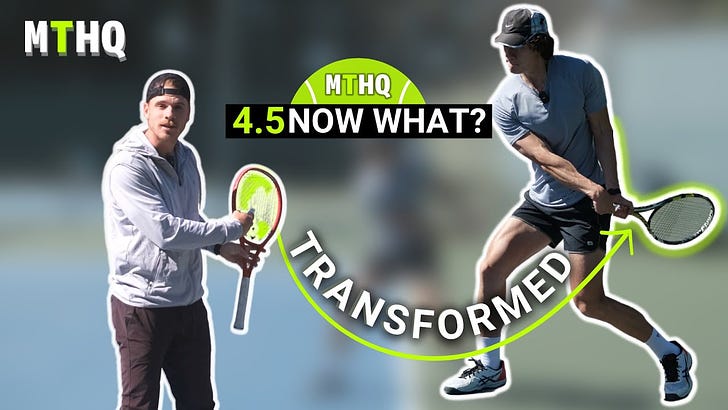


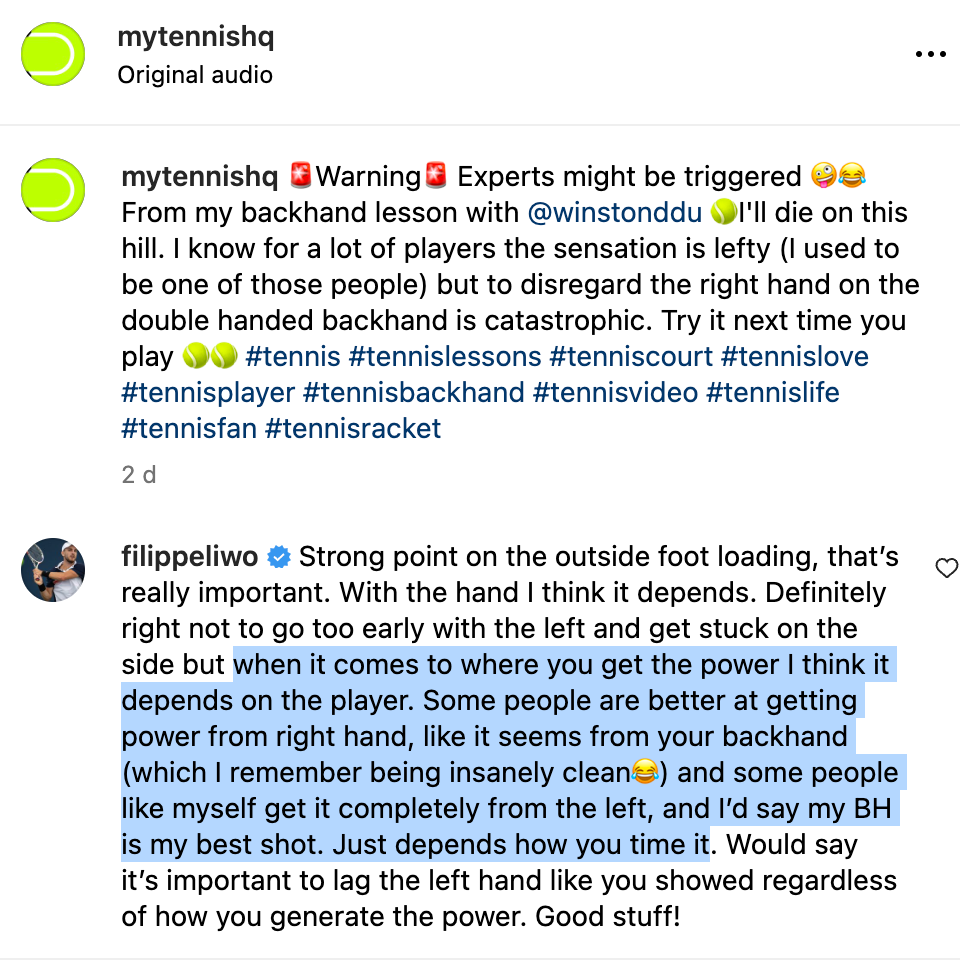

Great article. I was always told to use my right hand (left hand for righties)/my non-dominant arm more for my backhands, but always felt uncomfortable. I would try to force a racquet drop by rolling with my right hand, which led to some wrist and elbow pain. The best analogy with how it felt was like trying to throw a punch without any hip rotation.
When rebuilding my backhand, I read this one article I will link at the end by John Yandell which classifies backhands in a similar manner to how you do. I started to experiment with my backhand and ended up with what you classify as a straight left (right for right-handers) arm backhand. Something that really helped me out was throwing a medicine ball since the motion is almost the same as a backhand. The way my backhand now feels is like a figure eight where at the end of the backswing my arms get 'slotted' into position, then my hands automatically throw themselves into the ball. It kind of looks my Rune's backhand but with a straight arm.
I have gotten better strokes by relating them to other motions. Another example is my forehand was a wristy push to the ball until I related it to skipping a stone. Now I load, and the motion just happens (Fun fact I never figured out to lead with my elbow on my forehand until about a year ago). Have you had any epiphanies like this?
Article link - https://www.tennisplayer.net/public/avancedtennis/two_handed_backhand/2hd_bh_simplest_complex/Copy%20of%202hd_bh_simplest_complex.html
so, to clarify (this whole technique world is still so new to me aha), as I haven't seen the words take-back, outside-in or racket drop mentioned here, which here, if I summed it up well, the keys you gave to a great backhand in your previous pieces, is the whole dominant arm / hip and shoulder action-position thing different to the three worlds I mentioned; is it simply a thing of trade off (something that gives you perks and disadvantages but won't hurt you unless you miss the pair - like felix and berrettini) or is it actually something that can be used to rank backhands? do u think there is overall a "better" combination or do sinner's, rune's and djokovic's (for example) co-exist in that matter and really ranking a backhand comes to racket drop/takeback?
Thanks for that piece, as always.